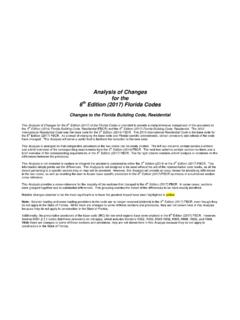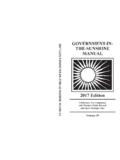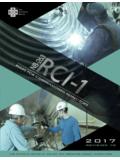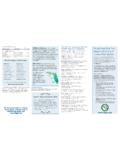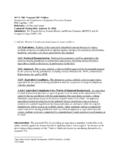Transcription of Principles of best practice 2016
1 INTERNATIONAL CONSENSUS UPDATE 2016. WOUND INFECTION IN. CLINICAL practice . Principles of best practice 2016. INTERNATIONAL CONSENSUS UPDATE 2016 | WOUND INFECTION IN CLINICAL practice . Supported by an educational grant from IWII. How to cite this document International Wound Infection Institute (IWII) Wound infection in clinical practice . Wounds International 2016. Sponsored by The views expressed in this publication are those of the authors and do not necessarily reflect those of the sponsors Produced by Wounds International a division of Omnia-Med Ltd Cargo Works, 1 2 Hatfields, London, SE1 9PG. All rights reserved 2016. No reproduction, copy or transmission of this publication may be made without written permission. No paragraph of this publication may be reproduced, copied or transmitted save with written permission or in accordance with the provisions of the Copyright, Designs and Patents Act 1988 or under the terms of any licence permitting limited copying issued by the Copyright Licensing Agency, 90 Tottenham Court Road, London, W1P 0LP Foreword T.
2 He International Wound Infection Institute (IWII) is an organisation of volunteer interdisciplinary health professionals dedicated to advancing and improving practice relating to prevention and control of wound infection. This includes acute wounds (surgical, traumatic and burns). and chronic wounds of all types, although principally chronic wounds of venous, arterial, diabetic and pressure aetiologies. Wound infection is a common complication of wounds. It leads to delays in wound healing and increases the risk of loss of limb and life. Implementation of effective strategies to prevent, diagnose and manage, is important in reducing mortality and morbidity rates associated with wound infection. This second edition of Wound Infection in Clinical practice is an update of the first edition published in 2008 by the World Union of Wound Healing Societies (WUWHS). The original document was authored by leading experts in wound management and endorsed by the WUWHS.
3 The intent of this edition is to provide a practical, updated resource that is easy-to-use and understand. For this edition, the IWII collaborative team has undertaken a comprehensive review of contemporary literature, including systematic reviews and meta-analyses when available. In addition, the team conducted a formal Delphi process to reach consensus on wound infection issues for which scientific research is minimal or lacking. This rigorous process provides an update on the science and expert opinion regarding prevention, diagnosis and control of wound infection. This edition outlines new definitions relevant to wound infection, presents new paradigms and advancements in the management and diagnosis of a wound infection, and highlights controversial areas of discussion. We hope this updated resource will guide your clinical practice and will serve as an informative resource for the education of other health professionals, as well as individuals with, or at risk of, wound infection.
4 Terry Swanson, NPWM. Project Chair Authors Terry Swanson, South West Healthcare, Warrnambool, Victoria (Australia). Donna Angel, Royal Perth Hospital, Perth (Australia). Geoff Sussman, Monash University, Melbourne (Australia) . Rose Cooper, Cardiff Metropolitan University, Cardiff (UK). Emily Haesler, Curtin University and Australian National University, Canberra (Australia). Karen Ousey, Institute of Skin Integrity and Infection Prevention, Huddersfield (UK). Keryln Carville, Silver Chain Group and Curtin University, Perth (Australia). Jacqui Fletcher, Independent Nurse Consultant (UK). Lindsay Kalan, University of Pennsylvania, Philadelphia, Pennsylvania (USA). David Keast, Lawson Health Research Institute, London, Ontario (Canada). David Leaper, Imperial College, London (UK). Greg Schultz, University of Florida, Gainsville, Florida (USA). Joyce Black, University of Nebraska Medical Center Omaha, Nebraska (USA).
5 Evan Call, EC Service and Weber State University, Centerville, Utah (USA). INTERNATIONAL CONSENSUS UPDATE 2016 | WOUND INFECTION IN CLINICAL practice . 3. Principles of best practice T. his update provides an opportunity to explore contemporary advances in wound infection knowledge and practice . Since 2008, scientific and clinical understanding of chronic wound infection has developed In particular, awareness of the presence and impact of wound biofilm has advanced enormously; however, understanding of its pathogenesis is yet to be clarified fully4-8. A holistic approach to individuals with, or at risk of, active wound infection remains essential to best practice in prevention, identification and management of wound infection. This is of particular importance in the context of increasing antibiotic resistance. This update is the result of a comprehensive literature review that identified relevant contemporary evidence, together with a formal Delphi process to establish expert consensus on topics where scientific evidence is lacking.
6 The full methodology is outlined in Appendix 1. Key updates appraised in this edition include: n The wound infection continuum n Definitions related to wound chronicity n Identification and diagnosis of wound infection n Topical and systemic management of wound infection using a holistic approach. The primary determinants of the pathological process through which presence of bacteria and other microorganisms results in wound infection and harmful effects on an individual with, or at risk of, a wound remains the same. These primary factors can be briefly outlined as: n The ability of the immune system to combat potential pathogens (host defence)9-11. n The number of microbes in the wound. A greater number of microbes can overwhelm host defences11. n The species of bacteria or microbe present. Some microbes have greater capacity to produce a detrimental effect in low numbers (virulence) and some are able to form and reform biofilm more , 13.
7 PP. The effectiveness of the host's defence system, together with the quantity and virulence of microbes, influences the development of wound infection practice POINT. INTERNATIONAL CONSENSUS UPDATE 2016 | WOUND INFECTION IN CLINICAL practice . 4. A holistic approach to DEFINITIONS. individuals with, or at risk International debate regarding the wound infection continuum and definitions associated of, active wound infection with wound infection is ongoing. A persistent area of contention has been identification remains essential to best of the point at which management of wound infection should commence, particularly practice in prevention, for wounds that do not exhibit the classic signs and symptoms associated with identification and wound infection. management of wound Through three rounds of Delphi voting, the IWII expert authors agreed on the following: infection. This is of particular importance in the context n Critical colonisation should be removed from the wound infection continuum due to the of increasing antibiotic lack of a specific definition or unanimous understanding of the term resistance.
8 N The term microbes' should replace bacteria' in the wound infection continuum, given the understanding that organisms other than bacteria ( fungi) are common causatives of wound infection n Presence of biofilm should be added to the wound infection continuum n Definitions for acute and chronic wounds. The IWII experts reached agreement on the following definitions: Acute wound: a wound with an aetiology that occurs suddenly, either with or without intention, but then heals in a timely manner. Chronic wound: a wound that has a slow progression through the healing phases, or shows delayed, interrupted or stalled healing due to intrinsic and extrinsic factors that impact on the individual and their wound. A chronic, non-healing wound could be suggestive of a biofilm, providing holistic evaluation has excluded or corrected underlying pathologies such as ischaemia. Biofilm: a structured community of microbes with genetic diversity and variable gene expression (phenotype) that creates behaviours and defences used to produce unique infections (chronic infection).
9 Biofilms are characterised by significant tolerance to antibiotics and biocides while remaining protected from host immunity. INTERNATIONAL CONSENSUS UPDATE 2016 | WOUND INFECTION IN CLINICAL practice . 5. The wound infection continuum PP W. ound infection is the invasion of a wound by proliferating microorganisms to a level that invokes a local and/or systemic response in the host. The presence of microorganisms within the wound causes local tissue damage and impedes wound , 11 Intervention is generally required to assist host defences in destroying the invading The wound infection continuum practice POINT provides a framework through which the impact microbes have on a wound and wound healing can be conceptualised (Figure 1). Wound infection STAGES IN THE WOUND INFECTION CONTINUUM. is the presence The relationship between the host, the wound and microorganisms in the development of of microbes in wound infection has been well described in the literature.
10 However, the concept of wound sufficient numbers microbial balance and the progression from a state of wound contamination to systemic or virulence to infection is yet to be established fully. cause a host It is well acknowledged that it is more than the presence of bacteria that leads to adverse response locally events in wounds. The wound infection continuum has been updated to reflect that and or systemically microbes other than bacteria are associated with wound infection, and microbial virulence (as well as numbers) contributes to the development of wound , 3, 11, 14-16 The stages in the wound infection continuum describe the gradual increase in the number and virulence Box 1: Advances in of microorganisms, together with the response they invoke within the host (Figure 1).3. terminology Contamination The term critical Wound contamination is the presence of non-proliferating microbes within a wound at a colonisation' has been a level that does not evoke a host , 3 Virtually from the time of wounding, all open topic of debate since it was wounds are contaminated with microbes.


